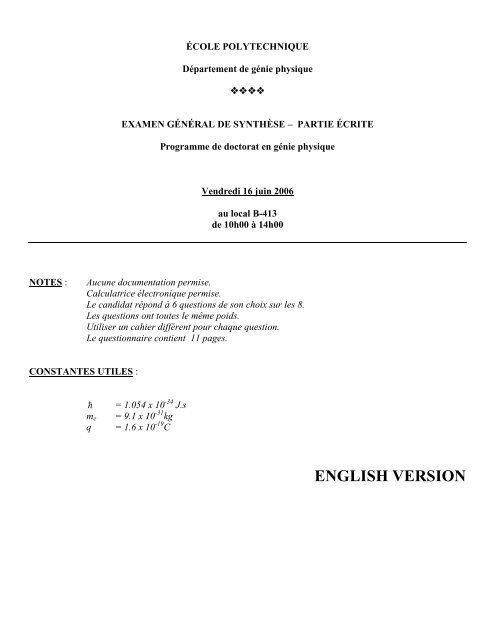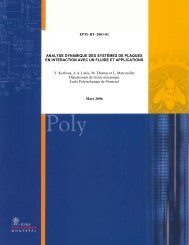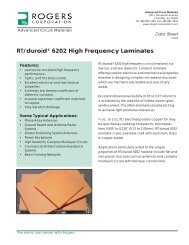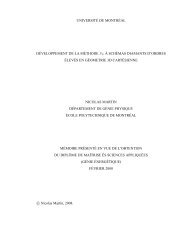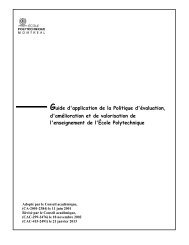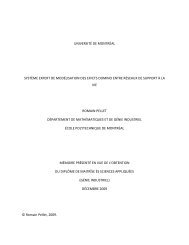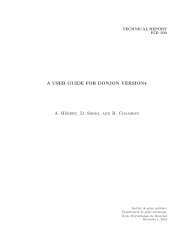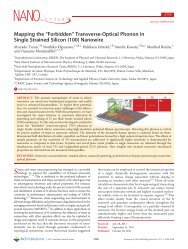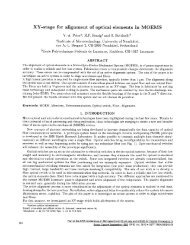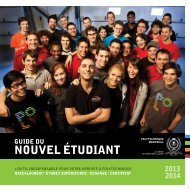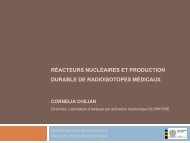final exam – written part - École Polytechnique de Montréal
final exam – written part - École Polytechnique de Montréal
final exam – written part - École Polytechnique de Montréal
Create successful ePaper yourself
Turn your PDF publications into a flip-book with our unique Google optimized e-Paper software.
ÉCOLE POLYTECHNIQUE<br />
Dé<strong>part</strong>ement <strong>de</strong> génie physique<br />
<br />
EXAMEN GÉNÉRAL DE SYNTHÈSE <strong>–</strong> PARTIE ÉCRITE<br />
Programme <strong>de</strong> doctorat en génie physique<br />
Vendredi 16 juin 2006<br />
au local B-413<br />
<strong>de</strong> 10h00 à 14h00<br />
NOTES :<br />
Aucune documentation permise.<br />
Calculatrice électronique permise.<br />
Le candidat répond à 6 questions <strong>de</strong> son choix sur les 8.<br />
Les questions ont toutes le même poids.<br />
Utiliser un cahier différent pour chaque question.<br />
Le questionnaire contient 11 pages.<br />
CONSTANTES UTILES :<br />
<br />
m e<br />
q<br />
= 1.054 x 10 -34 J.s<br />
= 9.1 x 10 -31 kg<br />
= 1.6 x 10 -19 C<br />
ENGLISH VERSION
QUESTION 1 :<br />
Skin effect<br />
For the following questions, you may consi<strong>de</strong>r a monochromatic plane wave of the form : exp ikz i t .<br />
a) Show that a good conductor behave as a dielectric with an effective permeability :<br />
eq<br />
i .<br />
b) For a material which is a good conductor, such as
QUESTION 2 :<br />
In a unidimensional box of length L where V(x) = 0 for 0 ≤ x ≤ L, and V(x) = ∞ elsewhere. We consi<strong>de</strong>r that the<br />
potential changes with time in the interval 0 ≤ x ≤ L as<br />
V 1<br />
(x)<br />
x<br />
L<br />
2 sin t<br />
(a)<br />
(b)<br />
Determine the probability that a ground state <strong>part</strong>icle (n = 1) makes a transition to the first excited state<br />
(n = 2) (you can consi<strong>de</strong>r that t to answer this question) ?<br />
What is the probability that the ground state <strong>part</strong>icle makes the transition to the second excited<br />
state (n = 3) ?<br />
(c) What happens to the results when 0 ?<br />
Examen général <strong>de</strong> synthèse - Partie écrite<br />
Vendredi 16 juin 2006<br />
Page 3 sur 11<br />
Dé<strong>part</strong>ement <strong>de</strong> génie physique
CONSTANTES, INTÉGRALES ET RELATIONS UTILES<br />
constantes<br />
m e = 9.11x10 -31 kg, 1 eV = 1.6022x10 -19 J, c = 3x10 8 m/s, e = 1.602x10 -19 C<br />
h = 6.6262x10 -34 J s, a 0 = 0.529177x10 -10 m, 0 = 8.854x10 -12 C 2 /Nm 2<br />
intégrales<br />
0<br />
x n e qx dx<br />
n!<br />
q n 1 , n 1, q 0<br />
sin<br />
cos<br />
x 2n e ax2 dx<br />
0<br />
0<br />
e i x x2 dx e 2 4<br />
x 2n 1 e ax2 dx<br />
xcos(ax)dx<br />
xsin(ax)dx<br />
1 3 5(2n 1)<br />
2 n 1 a n a<br />
n!<br />
,<br />
n 1<br />
2a<br />
(a 0)<br />
x<br />
1<br />
a cos(ax)<br />
2 1<br />
a sin(ax)<br />
2<br />
i<strong>de</strong>ntités trigonométriques<br />
a sin(ax)<br />
x<br />
a cos(ax)<br />
1<br />
sin sin<br />
2 cos( ) 1<br />
2 cos( ) cos cos 1<br />
2 cos( ) 1<br />
2 cos( )<br />
1<br />
2 sin( ) 1<br />
2 sin( ) cos sin 1<br />
2 sin( ) 1<br />
2 sin( )<br />
Examen général <strong>de</strong> synthèse - Partie écrite<br />
Vendredi 16 juin 2006<br />
Page 4 sur 11<br />
Dé<strong>part</strong>ement <strong>de</strong> génie physique
QUESTION 3 :<br />
Consi<strong>de</strong>r a one-dimensional lattice and assume that the energy of the conduction electrons is given by :<br />
k<br />
c<br />
<br />
2<br />
k<br />
2<br />
*<br />
2m<br />
e<br />
.<br />
where<br />
c<br />
is the conduction band minimum and<br />
a) Show that the <strong>de</strong>nsity of state g c ( ) of the electrons is<br />
*<br />
m<br />
e<br />
is the effective mass of the electrons.<br />
b)<br />
1<br />
2<br />
g<br />
c<br />
2<br />
<br />
2m<br />
e<br />
C<br />
c) Show that the electronic concentration n in the non-<strong>de</strong>generate case<br />
(where one can use the Maxwell-Boltzmann statistics) can be <strong>written</strong> as:<br />
n<br />
N exp F c<br />
c<br />
k T<br />
;<br />
B<br />
Determine N c . ( k B<br />
is the Botzmann constant and<br />
F<br />
the Fermi level).<br />
d) By inspection, <strong>de</strong>termine the concentration p of the holes.<br />
e) Calculate the intrinsic Fermi level as a function of the effectives masses.<br />
Usefull relation :<br />
0<br />
exp<br />
x<br />
1<br />
dx<br />
x<br />
Examen général <strong>de</strong> synthèse - Partie écrite<br />
Vendredi 16 juin 2006<br />
Page 5 sur 11<br />
Dé<strong>part</strong>ement <strong>de</strong> génie physique
QUESTION 4 :<br />
A rigid pendulum consists of a mass m fixed at the end A of a rigid rod. This rod is of length L and of<br />
negligeable mass. The gravitational field is vertically oriented downward and constant in time. The end B of the<br />
rod (the pivot) is following a forced vertical movement, given by a function h(t), around the fixed point O. This<br />
configuration is illusrated on figure 1.<br />
Determine the Lagrangian and the Hamiltonian of this system, using the horizontal line passing through the<br />
fixed point O as the reference for the potential.<br />
Figure 1<br />
Examen général <strong>de</strong> synthèse - Partie écrite<br />
Vendredi 16 juin 2006<br />
Page 6 sur 11<br />
Dé<strong>part</strong>ement <strong>de</strong> génie physique
QUESTION 5 :<br />
Propagation in a gra<strong>de</strong>d in<strong>de</strong>x lens<br />
A gra<strong>de</strong>d in<strong>de</strong>x lens with parallel end-faces has a refractive in<strong>de</strong>x with radial <strong>de</strong>pen<strong>de</strong>nce<br />
n 2 (r) n 0<br />
2<br />
ar 2<br />
where r is the distance from the central axis of the lens in a cylindrical coordinate system and n 0 is the in<strong>de</strong>x on<br />
the central axis.<br />
Using the ray equation of geometrical optics<br />
d<br />
ds n d r<br />
ds<br />
<br />
n<br />
answer the following questions :<br />
1. Calculate a function r(z) <strong>de</strong>scribing the path of a ray inci<strong>de</strong>nt at a distance r 0 from the center of the input<br />
face and perpendicular to this face. Use the paraxial approximation and eliminate negligible terms in<br />
your calculation if nee<strong>de</strong>d.<br />
2. What is the minimal thickness of the lens for an inci<strong>de</strong>nt plane wave on the input face to be focused to a<br />
point on the output face?<br />
3. What is the transfer matrix of this lens?<br />
4. What is the transfer matrix of four of these lenses placed in sequence and in contact? Comment.<br />
Examen général <strong>de</strong> synthèse - Partie écrite<br />
Vendredi 16 juin 2006<br />
Page 7 sur 11<br />
Dé<strong>part</strong>ement <strong>de</strong> génie physique
QUESTION 6 :<br />
The intensity of a source, i.e. the power emitted by the whole source per unit solid angle<br />
(W/steradian) in a given direction is given by:<br />
I( ) = I 0 cos n ( )<br />
a) Calculate the power contained in a cone with an angular spread of ± .<br />
b) Calculate the total power emitted by the source .<br />
Examen général <strong>de</strong> synthèse - Partie écrite<br />
Vendredi 16 juin 2006<br />
Page 8 sur 11<br />
Dé<strong>part</strong>ement <strong>de</strong> génie physique
QUESTION 7 :<br />
Fluctuations of magnetization in a paramagnet<br />
a) Show that for an electron with J<br />
M Ng J B<br />
0<br />
J<br />
b g ;<br />
g<br />
0H<br />
kT<br />
1<br />
2<br />
and g 2 that the general form of the magnetization<br />
Jb g b g c b gh b g<br />
1<br />
Where B J 1 2 coth J 1 2 1 2coth<br />
2<br />
J<br />
becomes M N 0<br />
tanhb 2g<br />
cosh 1<br />
cosh 1<br />
note : tanhb 2g<br />
b g<br />
; coth 2<br />
sinh b g b g b g<br />
sinh<br />
b g<br />
b) The <strong>part</strong>ition function for one atom “i” is<br />
c b<br />
b 2g<br />
m J sinh J<br />
ZibT, Hg expbm<br />
g<br />
sinh<br />
m J<br />
b g b g<br />
1 2<br />
gh<br />
Zi T, H 2cosh<br />
2 pour J 1 2 et g 2<br />
and the probability that a spin has energy Ei g Hm<br />
0<br />
is<br />
P i , m<br />
exp<br />
e<br />
b<br />
Ei<br />
Zi T,<br />
H<br />
j<br />
g<br />
where m l 1 2,<br />
1 2q .<br />
expb mg<br />
Zi T,<br />
H<br />
b<br />
g<br />
Find the fluctuation (or variance) of the magnetization (m) of one atom<br />
m<br />
2 2<br />
m m<br />
note :<br />
tanhb g<br />
sech 2 b g<br />
Examen général <strong>de</strong> synthèse - Partie écrite<br />
Vendredi 16 juin 2006<br />
Page 9 sur 11<br />
Dé<strong>part</strong>ement <strong>de</strong> génie physique
c) Find the fluctuation (or variance) of the total magnetization M using<br />
N<br />
2<br />
g 0<br />
m et M M<br />
2 2<br />
i 1<br />
d) Show that<br />
M<br />
2<br />
kT<br />
where<br />
M<br />
H<br />
is the magnetic susceptibility.<br />
e) The result in d) has the same form as that for energy fluctuations where<br />
E<br />
2<br />
kT<br />
2<br />
C V<br />
and C V<br />
are both response functions of a system.<br />
What is the response <strong>de</strong>scribed by ?<br />
What is the response <strong>de</strong>scribed by C V<br />
?<br />
Describe in one sentence the relationship between a response function and a fluctuation?<br />
Examen général <strong>de</strong> synthèse - Partie écrite<br />
Vendredi 16 juin 2006<br />
Page 10 sur 11<br />
Dé<strong>part</strong>ement <strong>de</strong> génie physique
QUESTION 8 :<br />
CONSTANTES UTILES :<br />
= 1.054 x 10 -34 J.s<br />
m e = 9.1 x 10 -31 kg<br />
q = 1.6 x 10 -19 C<br />
N<br />
23<br />
6.02 10 at<br />
1<br />
mol<br />
A<br />
-1<br />
Gold (Au) (atomic mass196.97 g mol ) is a monovalent metal which solidifies in a face centered cubic<br />
structure, with a <strong>de</strong>nsity of<br />
-3<br />
19.3 g cm .<br />
(1) Estimate the average separation R between an electron and a metal ion in the solid, and<br />
(2) the mean distance d between electrons.<br />
(3) Determine the mean free path ( ) of electrons at 273K if the resistivity (Au) = 22.8 n m à 0 C . Give<br />
the value of in nm.<br />
(4) Estimate <strong>de</strong> value of at 273 C .<br />
In all cases, clearly show your work and your assumptions.<br />
Examen général <strong>de</strong> synthèse - Partie écrite<br />
Vendredi 16 juin 2006<br />
Page 11 sur 11<br />
Dé<strong>part</strong>ement <strong>de</strong> génie physique


